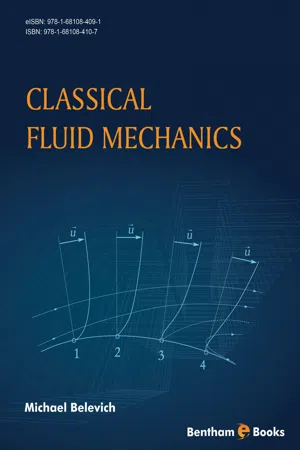
- English
- ePUB (mobile friendly)
- Available on iOS & Android
Classical Fluid Mechanics
About this book
This textbook primarily explains the construction of the classical fluid model to readers in a holistic manner. Secondly, the book also explains some possible modifications of the classical fluid model which either make the model applicable in some special cases (viscous or turbulent fluids) or simplify it in accordance with the specific mechanical properties (hydrostatics, two-dimensional flows, boundary layers, etc.). The book explains theoretical concepts in two parts. The first part is dedicated to the derivation of the classical model of the perfect fluid. The second part of the book covers important modifications to the fluid model which account for calculations of momentum, force and the laws of energy conservation. Concepts in this section include the redefinition of the stress tensor in cases of viscous or turbulent flows and laminar and turbulent boundary layers. The text is supplemented by appropriate exercises and problems which may be used in practical classes. These additions serve to teach students how to work with complex systems governed by differential equations. Classical Fluid Mechanics is an ideal textbook for students undertaking semester courses on fluid physics and mechanics in undergraduate degree programs.
Frequently asked questions
- Essential is ideal for learners and professionals who enjoy exploring a wide range of subjects. Access the Essential Library with 800,000+ trusted titles and best-sellers across business, personal growth, and the humanities. Includes unlimited reading time and Standard Read Aloud voice.
- Complete: Perfect for advanced learners and researchers needing full, unrestricted access. Unlock 1.4M+ books across hundreds of subjects, including academic and specialized titles. The Complete Plan also includes advanced features like Premium Read Aloud and Research Assistant.
Please note we cannot support devices running on iOS 13 and Android 7 or earlier. Learn more about using the app.
Information
Part I
Model of continuum
Bodies and Their Characteristics
Michael Belevich
Abstract
1.1. INTRODUCTION
Table of contents
- Welcome
- Table of Contents
- Title Page
- BENTHAM SCIENCE PUBLISHERS LTD.
- FOREWORD
- PREFACE
- Part I Model of continuum
- Bodies and Their Characteristics
- Basic Hypotheses and Laws
- Rates of Change of Characteristics of Continuum
- Minimum Information About Tensors
- Deformation
- The Continuity Equation
- Fluid Dynamics
- Energy
- Part II Applications of the fluid model
- Perfect Fluid
- Incompressible Perfect Fluid
- Viscous Fluid
- Related Topics
- Turbulent Fluid
- Boundary Layers
- Part III Supplement
- Fluid Mechanics from an Observer’s Viewpoint
- Exercises
- List of Notations
- Text Books for Further Reading
- References